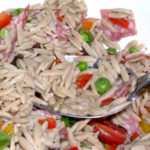Rice is something many of us cook rather frequently, and the instructions are relatively simple. Typically, instructions for cooking rice consist of placing the desired quantity of rice into a pot of boiling water, and then allowing the rice to simmer until the water is absorbed.
Simple, right? So then why does the cooked rice often appear differently than the picture on the box or in the recipe? The rice in the picture looks light and fluffy and delicious, while your rice is still somewhat soggy and has clumped together in a mass that looks something less than appetizing. Even instant rice has been known to suffer from this culinary calamity.
An important factor to observe when attempting to cook rice perfectly is to let the rice rest for about five minutes even after the allotted cooking time has expired. This allows the rice to continue to absorb any excess water that may still be left over, and the texture of the rice will become uniform throughout, important for consistency.
Of course, there are other factors involved that all play a role in how to cook rice perfectly, and the following tips and tricks will help to ensure that you cook perfect rice every time from now on.
Most instructions on how to cook rice will tell you to use 1 1/2 – 2 cups of water for every cup of rice you plan to cook and serve. The variation is due to the type of rice you may be cooking. Short grained rice, such as brown rice, will tend to use less water, while long grain rice, such as basmati, will require more water in order to fully expand. Additionally, too much water may make your rice sticky and soggy, but not enough water will result in a dry, harder rice. The perfect amount of water yields perfectly cooked rice, with loose, fluffy grains. Depending upon which type of rice you want to cook, you may need to experiment to find the perfect amount of water.
After the water has been brought to boiling and the rice added, you’ll be instructed to cover the pot and allow the rice to simmer in the water for about 10-15 minutes, (or longer, depending upon the rice; some types of wild rice will need as much as 30-40 minutes),
Make certain that the lid you use to cover the pot of rice fits snugly and securely, as the rice needs to steam within the pot. Add a tablespoon or two of butter or olive oil to the pot. This will add a bit of flavor and also keep the grains from sticking together while they cook. A bit of salt, preferably sea salt, will also add a bit of flavor, but be sure to add it after the water has boiled, as adding salt beforehand will cause the water to take longer to boil.
Another great tip to further ensure that your finished rice is not soggy is to place a piece of cloth between the lid and the pot, covering the rice. This helps keep the condensation that forms on the lid of the pot from falling back onto the rice. With a cloth covering the rice, you may be tempted to lift the lid and see how the rice is doing during the cooking process. Try to avoid doing this, as allowing the steam to escape every time you lift the lid can result in rice cooking less true to form.
After the rice has been cooked according to the instructions, check to see its consistency by fluffing it gently with a wooden fork or spoon. Gently, because you do not want to push at the grains of rice too hard, or you will either break them or force the rice in clumps, or both.
All the water should have been absorbed by now. If it seems that all is well, remember to let the rice rest for at least five minutes so that the texture becomes consistent throughout.
If the rice still seems too soggy or there is still water in the pot, try draining some of the water, and then continue to cook the rice over low heat for about five minutes.
If the rice is not cooked enough but there is no more water, then you’ll need to add a small amount of water to the pot and continue to simmer over low heat.
Now that you know how to cook rice perfectly, you may want to experiment with a few rice recipes. For rice recipes that are rather different than your typical white or brown rice, you may want to check out this article on Ghee Rice Recipes.
If you love rice and think you may be cooking a lot of it in the future, then you’ll want to invest in a rice recipe cookbook. Two great cookbooks containing a large assortment of various rice recipes are The Amazing World of Rice: With 150 Recipes for Pilafs, Paellas, Puddings, and More, by Marie Simmons, and Rice Bowl Recipes: Over 100 Tasty One-Dish Meals, by Mineko Asada




